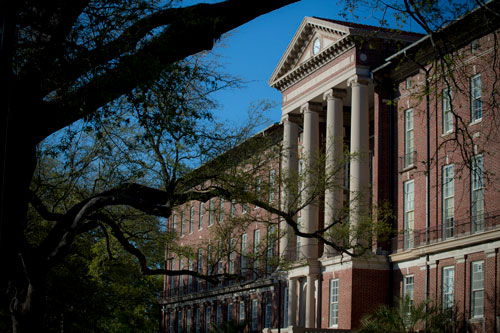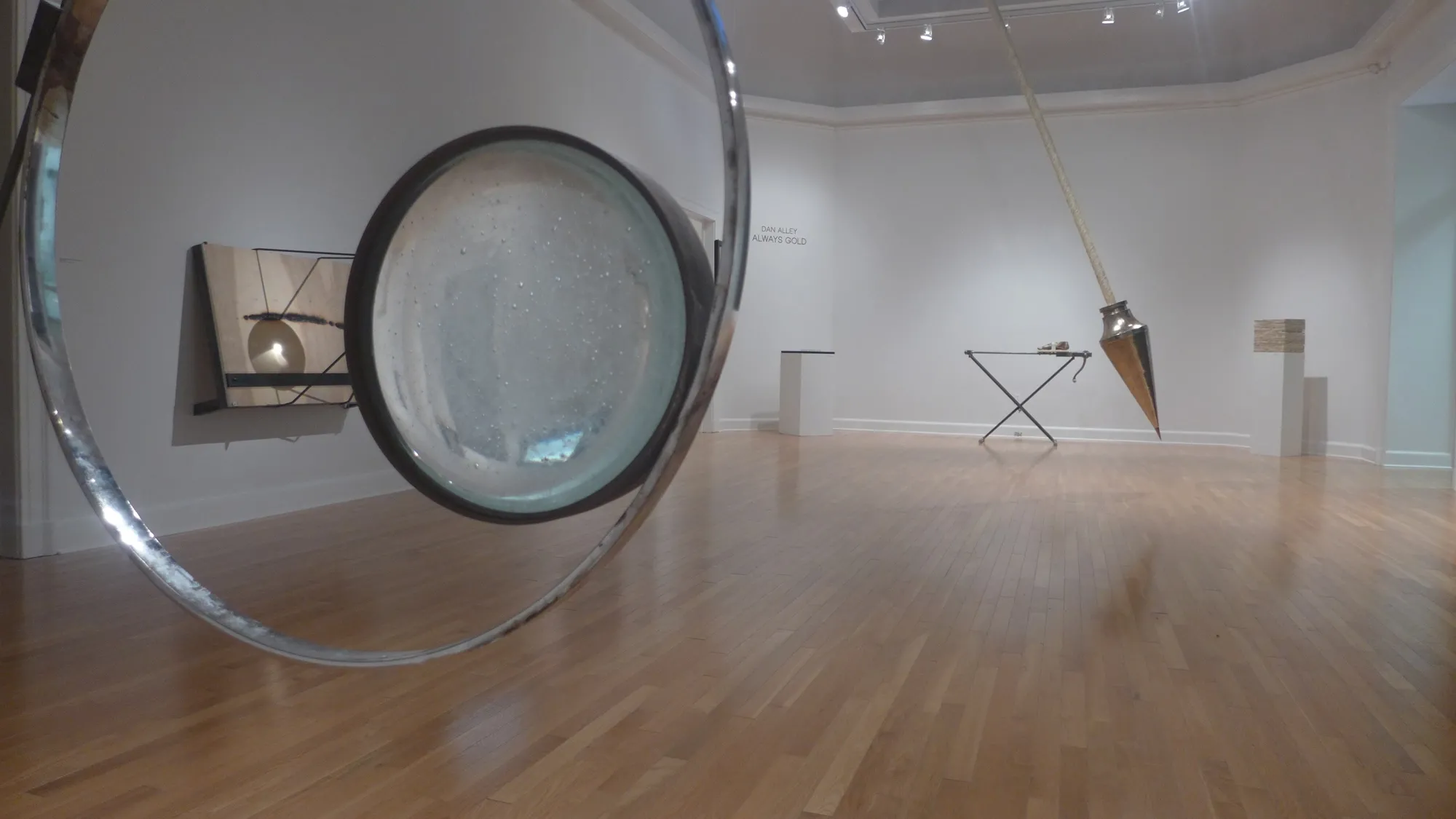The Newcomb Art Department offers a Master of Fine Arts degree in an intensive, interdisciplinary, two-year residency program that emphasizes close interaction with dedicated faculty and peers, and engagement with New Orleans’ unique cultural landscape. The graduate curriculum is focused on individual studio practice while also engaging students in cross-disciplinary seminars on art theory, professionalism, pedagogy, and practice-based research, as well as courses in the history of art.
Faculty
Diana Antohe
Instructor, Painting & Drawing, Printmaking
Director of Graduate Studies in Studio Art
dantohe@tulane.edu
http://www.dianaantohe.com
Anthony Baab
Senior Professor of Practice, Painting & Drawing
abaab@tulane.edu
http://anthonybaab.com
Wesley Chavis
Visiting Assistant Professor, Painting & Drawing
wchavis@tulane.edu
Teresa Cole
Professor, Printmaking
colet7@tulane.edu
http://teresacole.net/
Aaron Collier
Associate Professor, Painting & Drawing
acollier@tulane.edu
William DePauw
Senior Professor of Practice, Ceramics
wdepauw@tulane.edu
http://williamdepauw.net/
Jer’Lisa Devezin
Assistant Professor, Sculpture
jdevezin@tulane.edu
AnnieLaurie Erickson
Associate Professor, Photography
aerickso@tulane.edu
http://annielauriee.com/
Megan Hillerud
Visiting Assistant Professor, Glass
mhilleru@tulane.edu
Angie Jennings
Assistant Professor, Painting & Drawing
ajennings2@tulane.edu
Jeremy Jernegan
Professor, Ceramics
jjernega@tulane.edu
https://www.jeremyjernegan.com
Kristina Knipe
Visiting Assistant Professor, Photography
kknipe@tulane.edu
Christian Stock
Senior Professor of Practice, Glass
cstock@tulane.edu
Jonathan Traviesa
Instructor, Photography
jtravies@tulane.edu
Disciplines
Facilities
Graduate students are provided with a studio space and 24-hour access to world-class facilities in the Woldenberg Art Center. Sculpture houses a metal fabrication area, mixed media space, digital fabrication capabilities, and space for installation and performance. Ceramics includes large general studio workrooms as well as specialized clay, glaze and plaster mixing rooms, critique/computer and kiln rooms. Glass houses both a hot and cold shop, as well as a steel fabrication area. Printmaking has facilities for intaglio, lithography and silkscreen as well as its own darkroom. The Digital Arts studio includes 14 workstations with the latest software, five scanners, along with medium and large format printers. Photography includes an advanced digital imaging room with an Imacon film scanner and 44" inkjet printer, a computer lab with the latest software and large format inkjet printers, graduate and main darkrooms, lighting studio, and an equipment cage. Painting and Drawing maintains four large classrooms with entire walls of natural north light and color-balanced lighting overhead. The Department also has a 3D Fabrication shop containing a wood shop, CNC router, laser cutter, and 3D printer. The Carroll Gallery serves as the Newcomb Art Department’s exhibition space, and is dedicated to presenting professional exhibitions by students and faculty, including the annual MFA candidacy reviews and MFA thesis exhibitions. The Newcomb Art Museum features national and international exhibitions and programs that utilize the critical frameworks of diverse disciplines in conceptualizing and interpreting innovative art and design.
Funding
All MFA students are accepted with full scholarships comprised of a tuition waiver and an additional assistantship stipend. The tuition waiver covers the full cost of tuition for both years of the MFA program. The additional stipend is divided up into 20 bimonthly payments each year, beginning at the end of August and ending in May.
TA / Teaching
All MFA students TA for a professor in their area both semesters of their first year, and have the opportunity to teach their own undergraduate course both semesters of their second year.
Thesis Show
For the Thesis Show, each MFA student exhibits a culminating body of work in the Carrol Gallery, a gallery and exhibition space in the Woldenberg Art Center. Typically, the generously sized gallery is divided between two students although at times one student may utilize the entire space.
Degree Requirements and Sample Schedule
The Master of Fine Arts requires sixty (60) hours of graduate level courses. Two courses in Art History (6 hours) at the graduate level are required, as is attendance in the MFA seminar courses (12 hours) that are held each semester and rotate in theme (Pedagogy, Professionalism, Studio Practice, Art Theory). Of the remaining courses (42 hours) 30 hours must be in studio disciplines and are designed to meet individual needs and interests. These are mainly of a “workshop” or “atelier” nature. During the second year, all students are required to present a thesis exhibition in the Carroll Gallery and complete a written thesis contextualizing the exhibition. In addition, an oral examination is conducted by an appointed faculty thesis committee.
First Year
Fall semester
ARST 7020: 3 credits (Studio work)
ARHS 7920: Cannon in Crisis: 3 credits (Art History)
ARST 7800: 3 credits (MFA seminar, rotating theme)
ARST 7810: 3 credits (Studio Art MFA Critique Class)
ARST 7040: 3 credits (Studio work)
ARHS at the 6000 or 7000 level: 3 credits
ARST 7800: 3 credits (MFA seminar, rotating theme)
ARST 7810: 3 credits (Studio Art MFA Critique Class)
Second Year
ARST 7410: 3 credits (Studio work)
ARST 7800: 3 credits (MFA seminar, rotating theme)
ARST 7810: 3 credits (Studio Art MFA Critique Class)
ARST 7430: 3 credits (Studio work)
ARST 7450: Thesis Project: 3 credits (Exhibition and written thesis)
ARST 7800: 3 credits (MFA seminar, rotating theme)
ARST 7810: 3 credits (Studio Art MFA Critique Class)
Total: 60 credits
Department FAQ
Artist Statement
Address the work you submitted in your portfolio and contextualize your current artistic production and research. This statement should include relevant influences on your work and practice. This should also attempt to situate the work within a historical and contemporary framework. The statement should be 1 page.
What should I address in my Statement of Purpose?
Describe your purpose in undertaking graduate work. Discuss future directions or goals for your work, and describe how the Master of Fine Arts in Studio Art at Tulane is particularly suited to your professional goals.
Is there a recommended length for the Statement of Purpose?
In the application, you are directed to attach a document (word or PDF). Please make sure this document is not more than a few pages of writing. 1-2 pages is normal.
If admitted, will I get a stipend and/or tuition waiver?
All MFA students are accepted with full scholarships comprised of a tuition waiver and an additional assistantship stipend. The tuition waiver covers the full cost of tuition for both years of the MFA program. The additional stipend is divided up into 20 bimonthly payments each year, beginning at the end of August and ending in May.
Do I need to have a BFA in order to apply?
No. Although an undergraduate degree is required, it is not required that is was undertaken as an art major.
Is it possible to apply to the graduate program and receive funding as an international student?
Yes.
Is TOEFL required for students from non-English speaking countries?
All applicants must present satisfactory evidence of sufficient competence to read, write, speak and understand spoken English. If you are from a non-English speaking country you are required to submit a TOEFL score unless you have received a degree from a U.S. University or a University in which courses were taught in English. TOEFL scores should also be sent to Tulane School of Liberal Arts, code: 6183.
What will my critiques be like?
In the first year of the program, MFA Candidates are assigned a committee of three faculty members. Candidates meet with their committees twice a semester (mid and end) for one hour, however they are strongly encouraged to schedule meetings with faculty members outside of these structured reviews. In the second year, candidates have the option to select new committee members from the studio art faculty and can add additional members from outside the department for the thesis committee. Additional critiques take place during graduate seminar which occurs each semester.
What if I took the GRE, should I send my scores although they are not required?
No. Do not send your GRE scores.
Is there an admission deadline in the fall to begin the program in the spring?
No. There is only one annual deadline for admission to the MFA program: January 10th of every year. All incoming MFA students start the program in the fall.
Do you accept students for part-time study?
No.
Is teaching a part of the MFA program?
All MFA students TA for a professor in their area both semesters of their first year, and have the opportunity to teach their own undergraduate course both semesters of their second year.
What if I work across various media, which area should I apply to?
Although the faculty are fully supportive of interdisciplinary work, you need to specify which area you are applying to (Ceramics, Digital Arts, Glass, Painting, Photography, Printmaking, or Sculpture). Feel free to email professors in the areas that you're interested in to try and assess which area would make the most sense for your potential admittance. Matriculating students are welcome to make work across various media during their time in the MFA program, but every MFA student assists and teaches in their area of admittance.
Who should write my recommendation letters?
Ideally, your professors of art (or related fields) should be asked because they often write the most applicable letters of recommendation. Fellow arts professionals can best evaluate how the applicant has performed in the past and will be able to handle entering the intensive environment of a graduate level Studio Art program. However, anyone who can speak to the applicant's intellectual abilities, level of maturity, and artistic ability would be a good person to ask.
Is it possible to receive an application fee waiver?
An application fee waiver is ONLY available to verified McNair Scholars. If you are a McNair Scholar please contact the Graduate Programs office: aschumac@tulane.edu for the fee waiver code. All other applications cannot be submitted without payment of the $50 application fee in full. Payments must be made online with a credit card (Visa, MasterCard, American Express or Discover card).
Admissions Requirements / FAQ / Timeline
Application deadline is January 10th. All requirements can be completed online through the School of Liberal Arts application system. See: School of Liberal Arts: applying to the graduate program before filling out the School of Liberal Arts application form
*Please note that the GRE is not required of MFA applicants in studio art.
Application materials for the MFA program in studio art include:
- Portfolio (in a single PDF that includes an artist statement and CV-further instructions below under PDF portfolio) and corresponding Inventory List
- Statement of Purpose (1-2 pages addressing interests, influences, a brief bio as it relates to current direction of work, and reasons for applying to graduate school at this time)
- Letters of Recommendation (3)
- Unofficial academic transcripts of all undergraduate and/or graduate study (Official transcripts are required upon admission to the program)
- CV/Resume optional
PDF Portfolio
Your PDF must include the following, in this order:
- Current artist statement that relates to the work in your portfolio (500 word maximum)
- Portfolio of recent work that indicates your primary interest and direction
- Current CV (3 page maximum)
- Label your PDF Lastname_Firstname.pdf
- Your PDF should be less that 20mb
Still images
- Maximum of 20 images
- On each page of the portfolio include all pertinent info (Title, Year, Size, Materials)
Time-based work
- Limit your time-based work samples to no more than ten minutes total.
- Time-based files should be uploaded on your website, Vimeo or Youtube.
- Include a still image and a link to these files in the portfolio section of your PDF
- Below the image on each page of the portfolio include all pertinent info (Title, Year, Duration)
MFA Guidelines
Contact
If you have general questions about the MFA program that are not answered on this page, the MFA Program FAQ, or Studio Art MFA Program Guidelines, please email Molly LeBlanc at mleblan7@tulane.edu.

